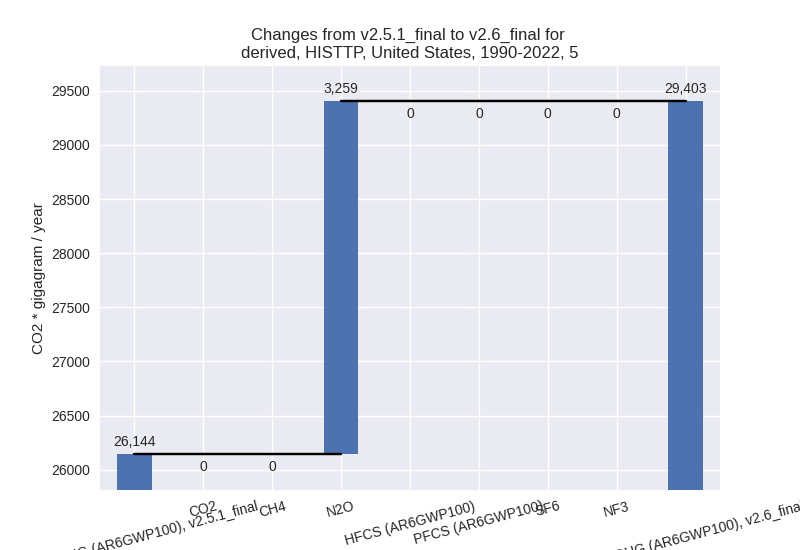Changes in PRIMAP-hist v2.6_final compared to v2.5.1_final for United States
2024-09-24
Johannes Gütschow
Change analysis for United States for PRIMAP-hist v2.6_final compared to v2.5.1_final
Overview over emissions by sector and gas
The following figures show the aggregate national total emissions excluding LULUCF AR6GWP100 for the country reported priority scenario. The dotted linesshow the v2.5.1_final data.
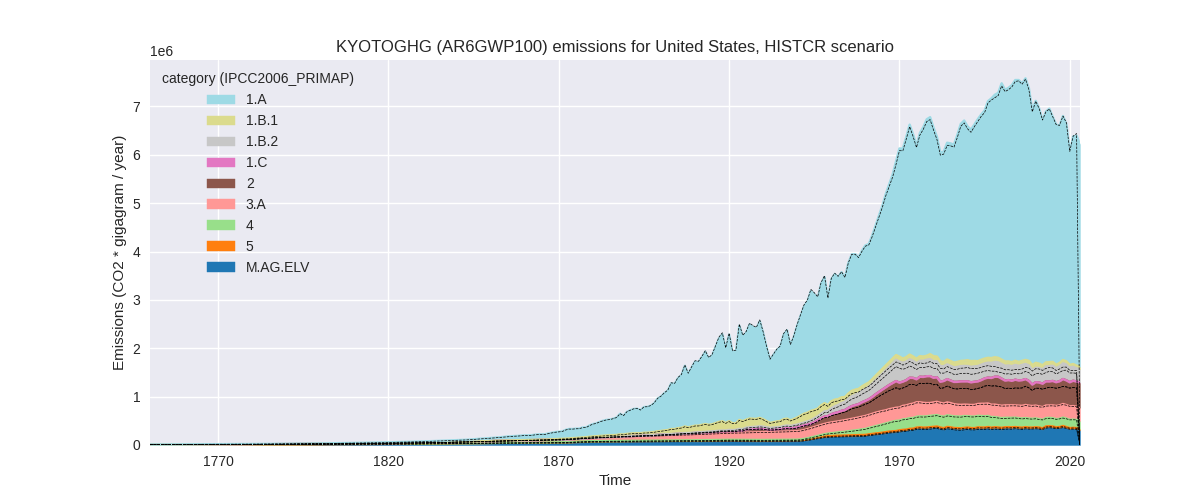
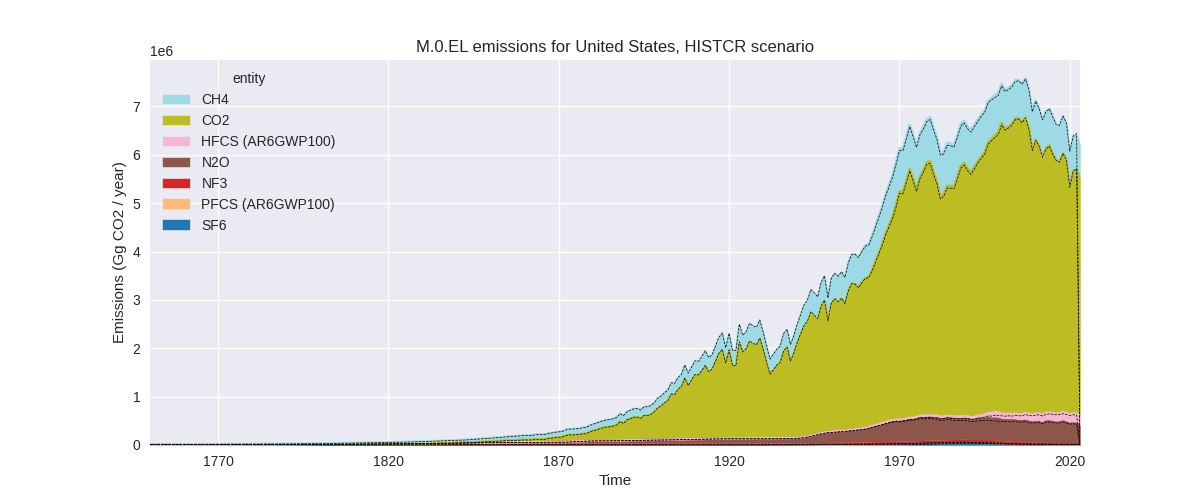
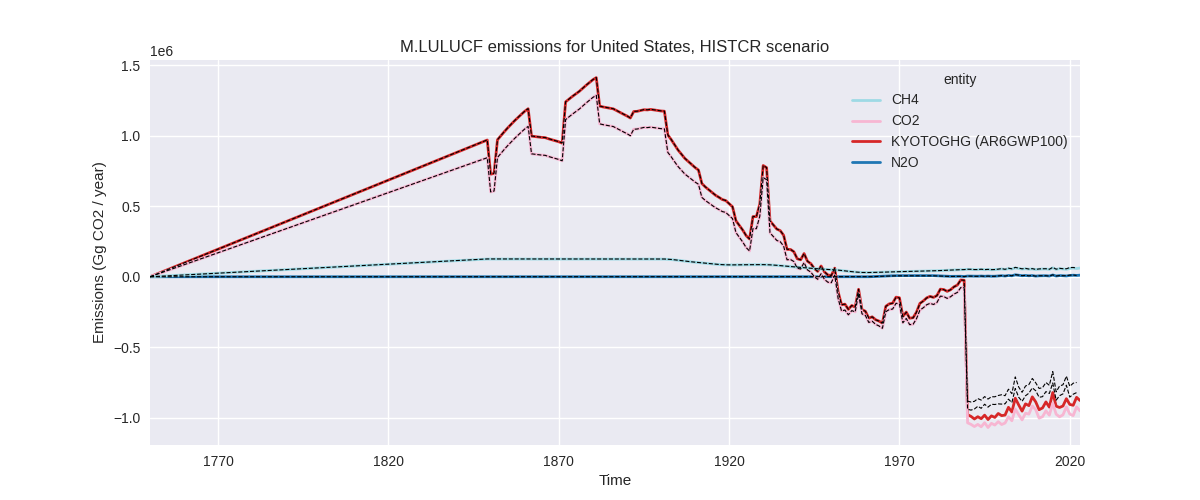
The following figures show the aggregate national total emissions excluding LULUCF AR6GWP100 for the third party priority scenario. The dotted linesshow the v2.5.1_final data.
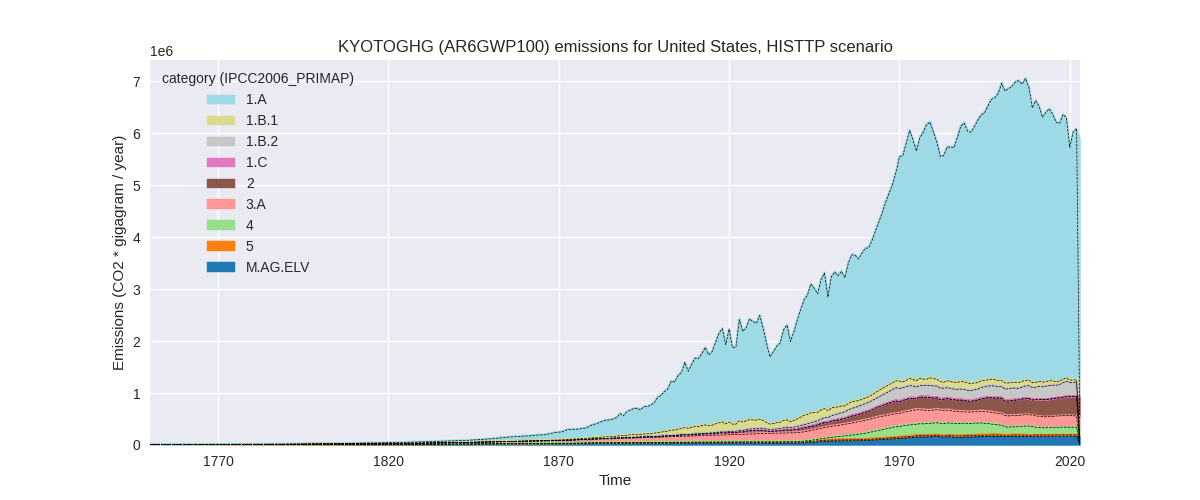

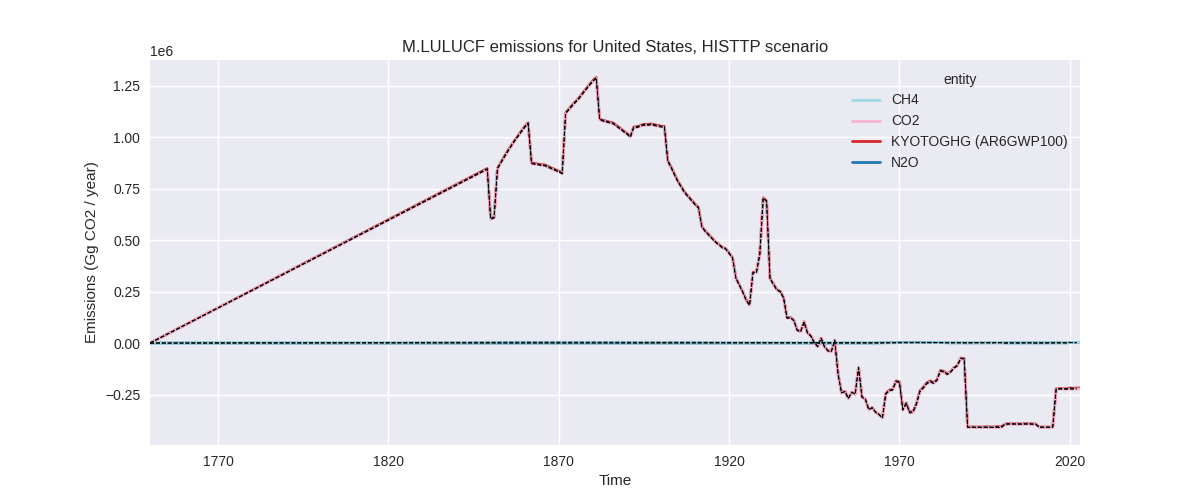
Overview over changes
In the country reported priority scenario we have the following changes for aggregate Kyoto GHG and national total emissions excluding LULUCF (M.0.EL):
- Emissions in 2022 have changed by -0.7%% (-44958.90 Gg CO2 / year)
- Emissions in 1990-2022 have changed by 0.3%% (19857.90 Gg CO2 / year)
In the third party priority scenario we have the following changes for aggregate Kyoto GHG and national total emissions excluding LULUCF (M.0.EL):
- Emissions in 2022 have changed by -0.4%% (-26122.30 Gg CO2 / year)
- Emissions in 1990-2022 have changed by 0.1%% (4088.29 Gg CO2 / year)
Most important changes per scenario and time frame
In the country reported priority scenario the following sector-gas combinations have the highest absolute impact on national total KyotoGHG (AR6GWP100) emissions in 2022 (top 5):
- 1: 1.A, CO2 with -150024.00 Gg CO2 / year (-3.1%)
- 2: 2, CO2 with 102220.38 Gg CO2 / year (60.3%)
- 3: 2, HFCS (AR6GWP100) with 28453.93 Gg CO2 / year (15.3%)
- 4: 1.B.2, CH4 with -26415.33 Gg CO2 / year (-10.7%)
- 5: 4, CH4 with -4396.76 Gg CO2 / year (-3.0%)
In the country reported priority scenario the following sector-gas combinations have the highest absolute impact on national total KyotoGHG (AR6GWP100) emissions in 1990-2022 (top 5):
- 1: 1.A, CO2 with -126221.78 Gg CO2 / year (-2.4%)
- 2: 2, CO2 with 107133.61 Gg CO2 / year (55.9%)
- 3: 2, HFCS (AR6GWP100) with 16449.05 Gg CO2 / year (12.8%)
- 4: 2, PFCS (AR6GWP100) with 9495.02 Gg CO2 / year (91.9%)
- 5: 2, SF6 with 4730.60 Gg CO2 / year (28.1%)
In the third party priority scenario the following sector-gas combinations have the highest absolute impact on national total KyotoGHG (AR6GWP100) emissions in 2022 (top 5):
- 1: 1.A, CO2 with -31737.90 Gg CO2 / year (-0.7%)
- 2: 2, HFCS (AR6GWP100) with 5360.35 Gg CO2 / year (3.0%)
- 3: 4, CH4 with 4099.64 Gg CO2 / year (2.9%)
- 4: 2, SF6 with -3423.25 Gg CO2 / year (-10.2%)
- 5: 5, N2O with -2523.85 Gg CO2 / year (-13.6%)
In the third party priority scenario the following sector-gas combinations have the highest absolute impact on national total KyotoGHG (AR6GWP100) emissions in 1990-2022 (top 5):
- 1: 5, N2O with 3259.31 Gg CO2 / year (15.5%)
- 2: 1.A, CO2 with -1487.00 Gg CO2 / year (-0.0%)
- 3: 4, CH4 with 605.52 Gg CO2 / year (0.4%)
- 4: 2, HFCS (AR6GWP100) with 162.43 Gg CO2 / year (0.2%)
- 5: 2, N2O with 141.19 Gg CO2 / year (0.6%)
Notes on data changes
Here we list notes explaining important emissions changes for the country. ’' means that the following text only applies to the TP time series, while means that it only applies to the CR scenario. Otherwise the note applies to both scenarios.
- We have added data from the official 2024 release of the US GHG inventory.
- The USA report non-energy use of fuels under 1.A.5 in CRF. We have mapped the non-energy use of fuels data reported in the 2024 inventory to 2.D (Non-energy products from fuels and solvent use). Thus we have changes for categories 1.A and 2.D which don’t affect the totals, as emissions are moved from 1.A to 2.D (CR scenario).
- F-gas emissions estimates are higher in the 2024 inventory than in
CRF2023 data and in consequently higher in PRIMAP-hist v2.6 than in
v2.5.1 (CR scenario).
- 2022 changes in the TP scenario are due to updated 2022 data (E I2024, and for f-gases the 2024 inventory which is used for 2022 growth rates)
Changes by sector and gas
For each scenario and time frame the changes are displayed for all individual sectors and all individual gases. In the sector plot we use aggregate Kyoto GHGs in AR6GWP100. In the gas plot we usenational total emissions without LULUCF. ## country reported scenario
2022
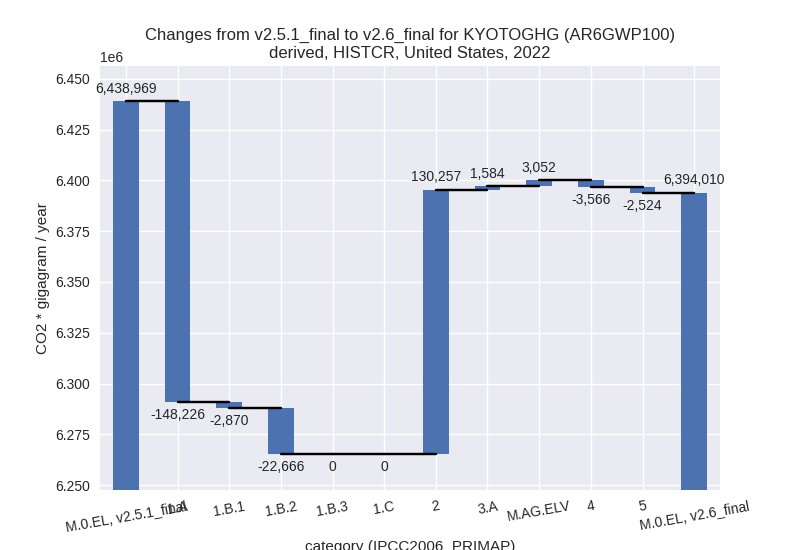
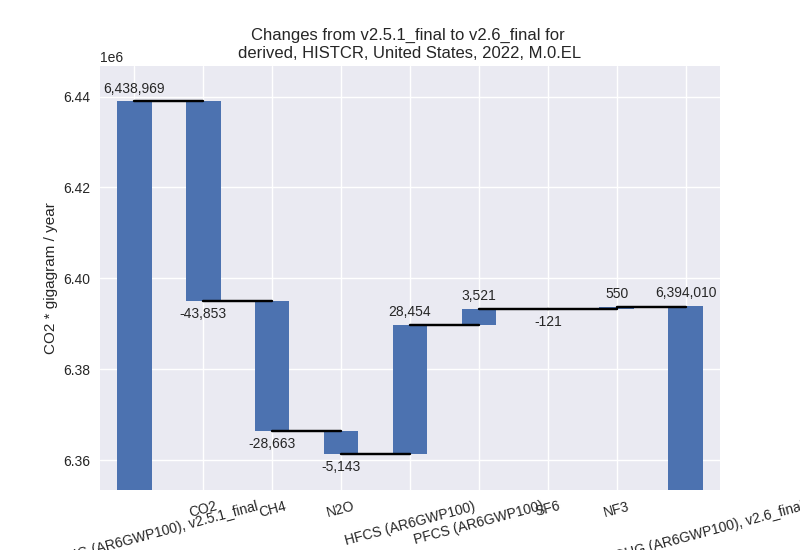
1990-2022
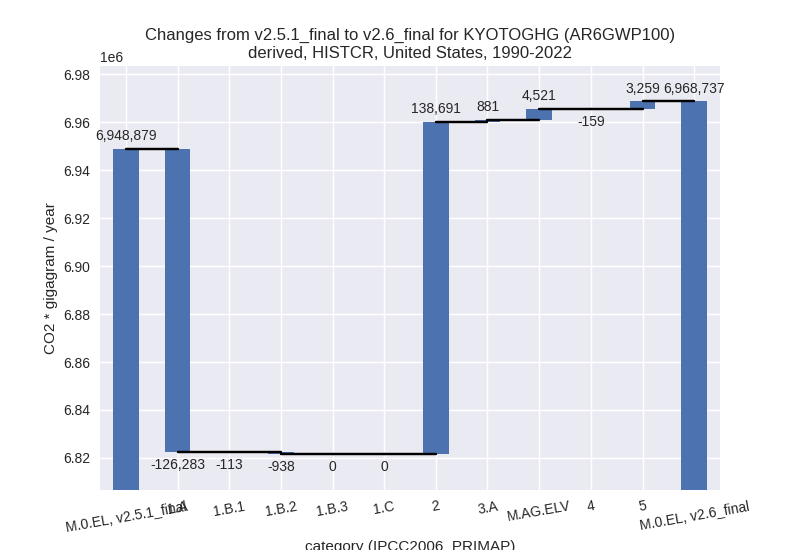
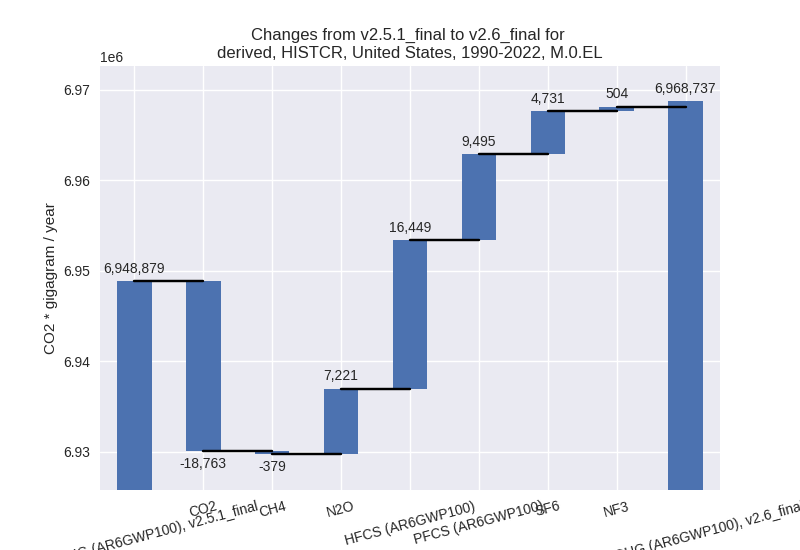
third party scenario
2022

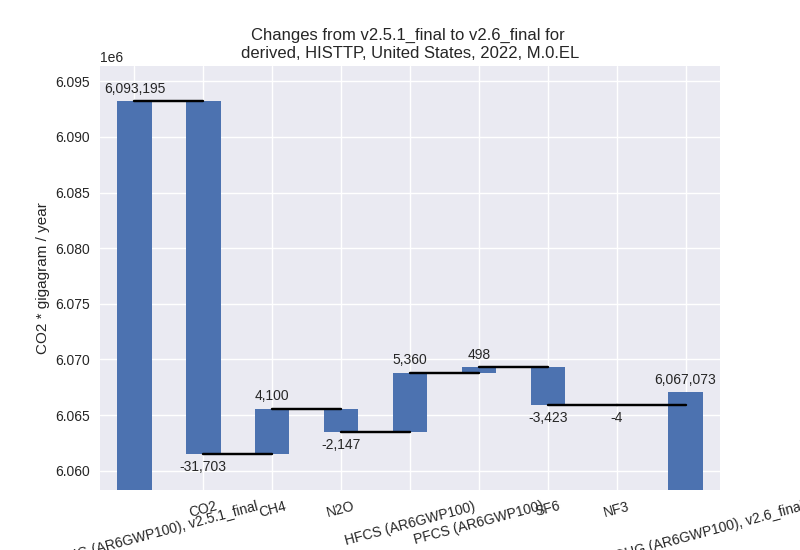
1990-2022
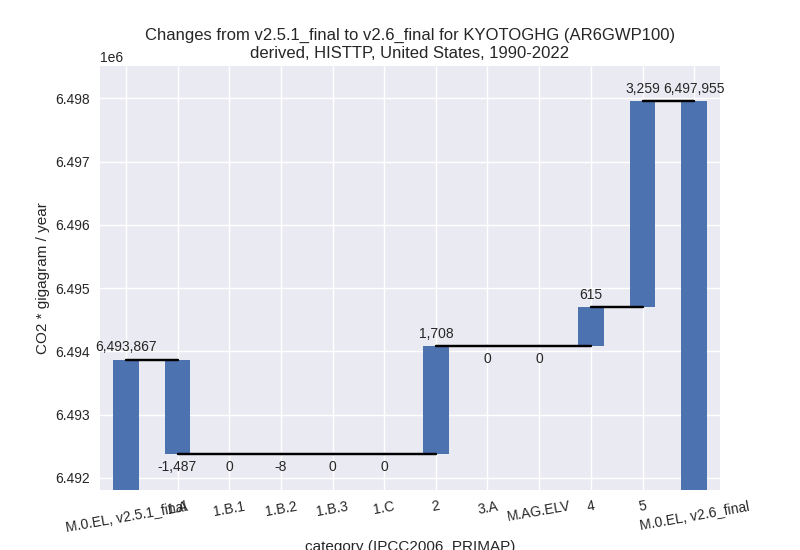
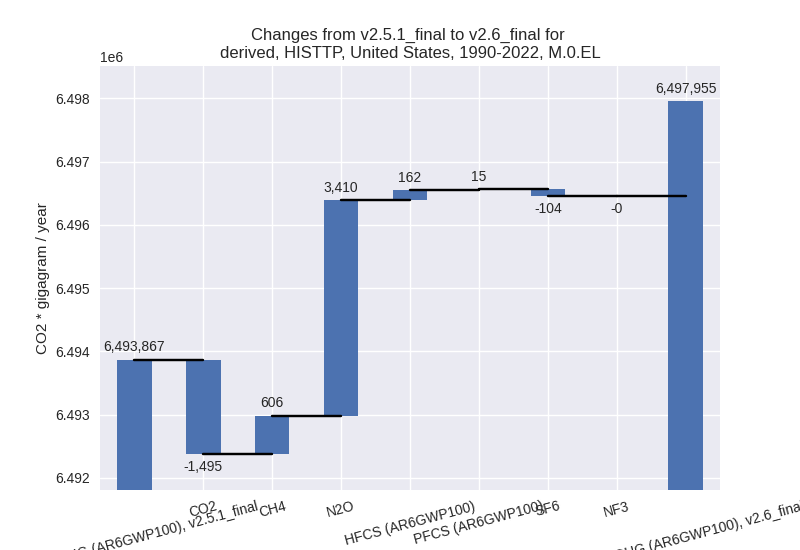
Detailed changes for the scenarios:
country reported scenario (HISTCR):
Most important changes per time frame
For 2022 the following sector-gas combinations have the highest absolute impact on national total KyotoGHG (AR6GWP100) emissions in 2022 (top 5):
- 1: 1.A, CO2 with -150024.00 Gg CO2 / year (-3.1%)
- 2: 2, CO2 with 102220.38 Gg CO2 / year (60.3%)
- 3: 2, HFCS (AR6GWP100) with 28453.93 Gg CO2 / year (15.3%)
- 4: 1.B.2, CH4 with -26415.33 Gg CO2 / year (-10.7%)
- 5: 4, CH4 with -4396.76 Gg CO2 / year (-3.0%)
For 1990-2022 the following sector-gas combinations have the highest absolute impact on national total KyotoGHG (AR6GWP100) emissions in 1990-2022 (top 5):
- 1: 1.A, CO2 with -126221.78 Gg CO2 / year (-2.4%)
- 2: 2, CO2 with 107133.61 Gg CO2 / year (55.9%)
- 3: 2, HFCS (AR6GWP100) with 16449.05 Gg CO2 / year (12.8%)
- 4: 2, PFCS (AR6GWP100) with 9495.02 Gg CO2 / year (91.9%)
- 5: 2, SF6 with 4730.60 Gg CO2 / year (28.1%)
Changes in the main sectors for aggregate KyotoGHG (AR6GWP100) are
- 1: Total sectoral emissions in 2022 are 5084799.60
Gg CO2 / year which is 79.5% of M.0.EL emissions. 2022 Emissions have
changed by -3.3% (-173761.90 Gg CO2
/ year). 1990-2022 Emissions have changed by -2.2% (-127334.70 Gg CO2 / year). For 2022
the changes per gas
are:
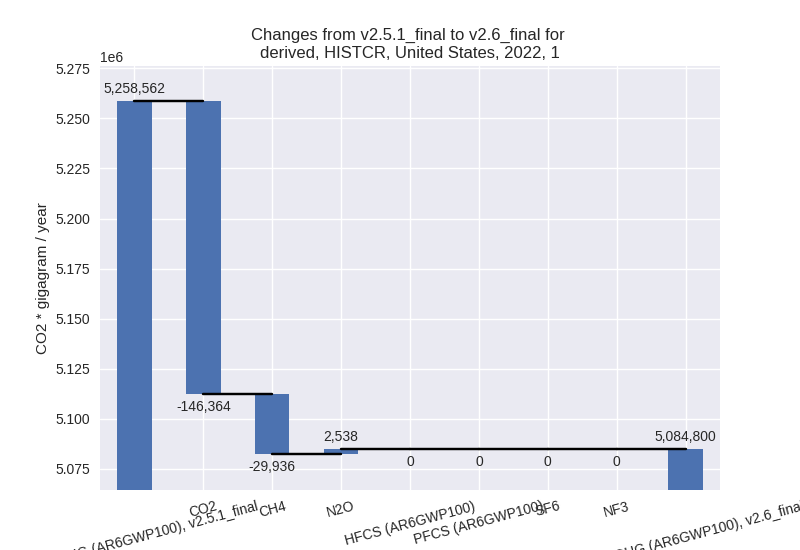
For 1990-2022 the changes per gas are: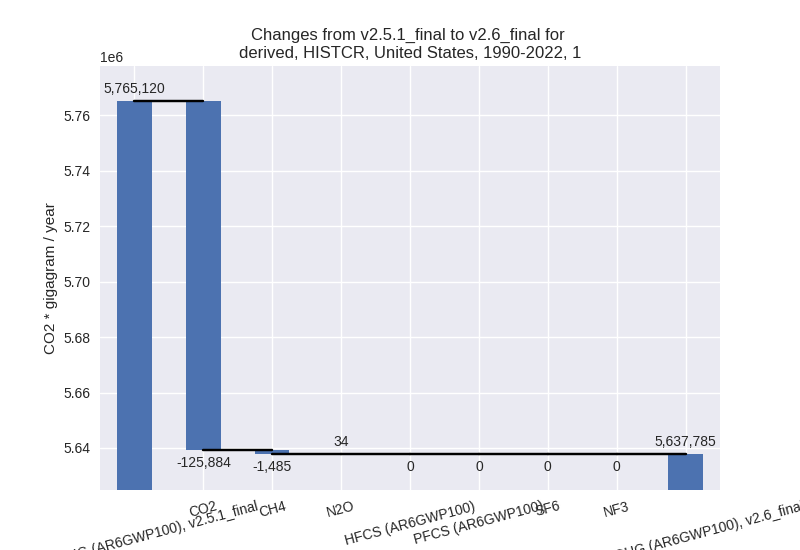
The changes come from the following subsectors:- 1.A: Total sectoral emissions in 2022 are
4753424.00 Gg CO2 / year which is 93.5% of category 1 emissions. 2022
Emissions have changed by -3.0%
(-148226.10 Gg CO2 / year). 1990-2022 Emissions have changed by -2.4% (-126283.09 Gg CO2 / year). For 2022
the changes per gas
are:
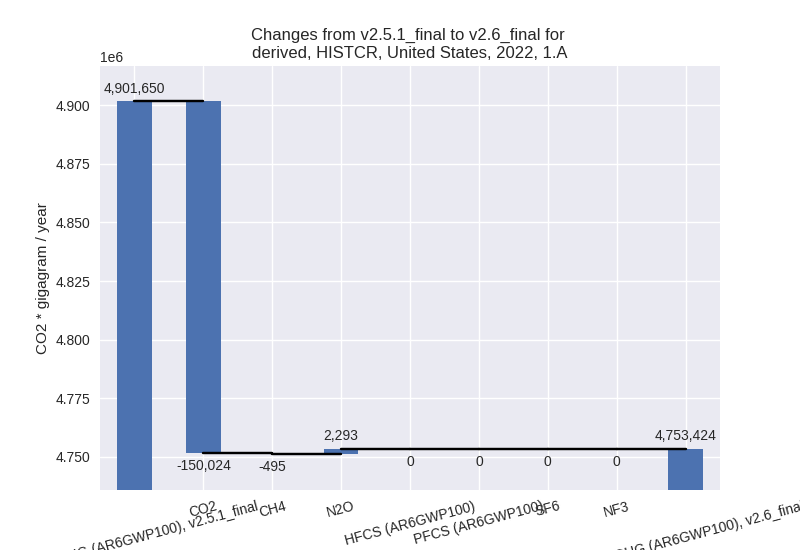
For 1990-2022 the changes per gas are: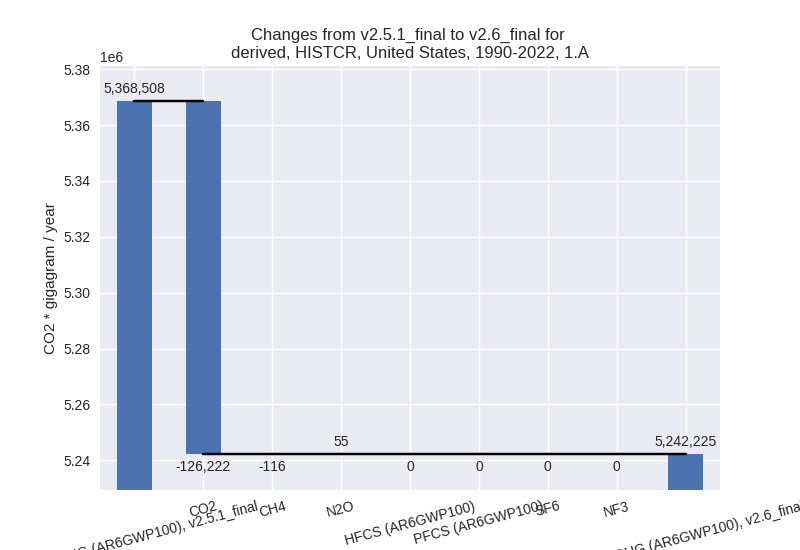
There is no subsector information available in PRIMAP-hist. - 1.B.1: Total sectoral emissions in 2022 are
52219.70 Gg CO2 / year which is 1.0% of category 1 emissions. 2022
Emissions have changed by -5.2%
(-2869.79 Gg CO2 / year). 1990-2022 Emissions have changed by -0.1% (-113.43 Gg CO2 / year). For 2022
the changes per gas
are:
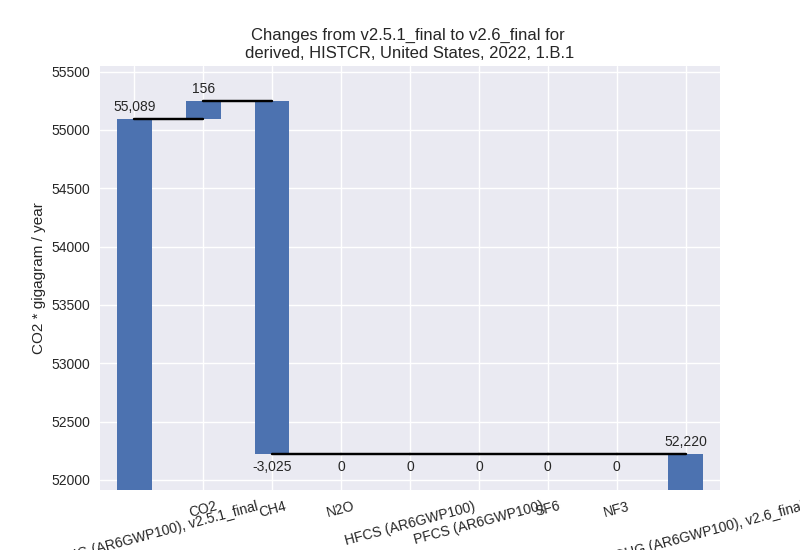
There is no subsector information available in PRIMAP-hist. - 1.B.2: Total sectoral emissions in 2022 are
279155.90 Gg CO2 / year which is 5.5% of category 1 emissions. 2022
Emissions have changed by -7.5%
(-22665.98 Gg CO2 / year). 1990-2022 Emissions have changed by -0.3% (-938.18 Gg CO2 / year). For 2022
the changes per gas
are:
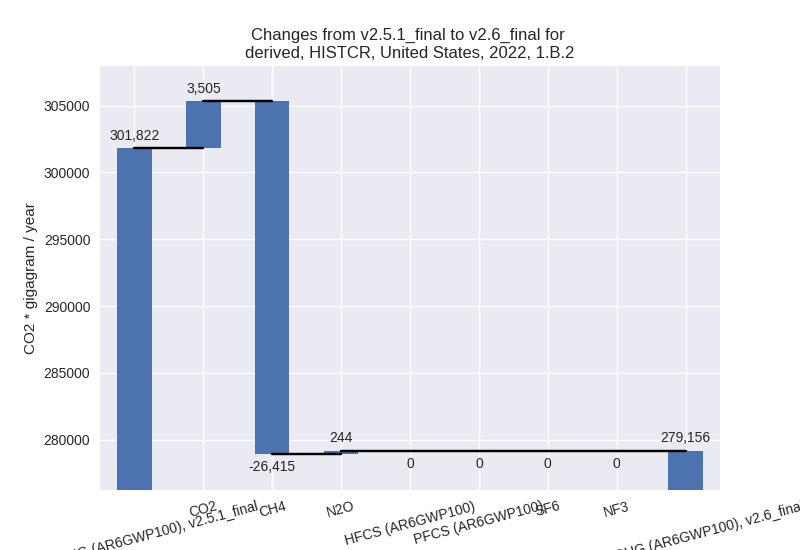
There is no subsector information available in PRIMAP-hist.
- 1.A: Total sectoral emissions in 2022 are
4753424.00 Gg CO2 / year which is 93.5% of category 1 emissions. 2022
Emissions have changed by -3.0%
(-148226.10 Gg CO2 / year). 1990-2022 Emissions have changed by -2.4% (-126283.09 Gg CO2 / year). For 2022
the changes per gas
are:
- 2: Total sectoral emissions in 2022 are 519136.81
Gg CO2 / year which is 8.1% of M.0.EL emissions. 2022 Emissions have
changed by 33.5% (130257.37 Gg CO2 /
year). 1990-2022 Emissions have changed by 37.3% (138690.74 Gg CO2 / year). For 2022
the changes per gas
are:
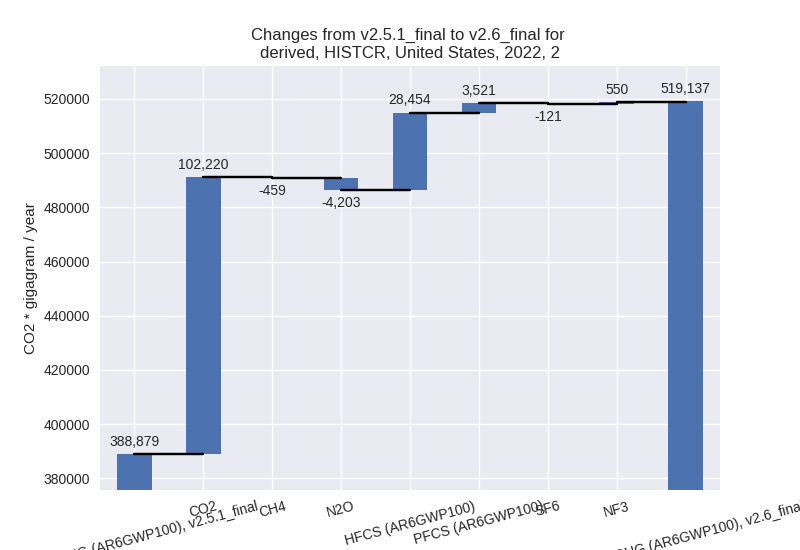
For 1990-2022 the changes per gas are: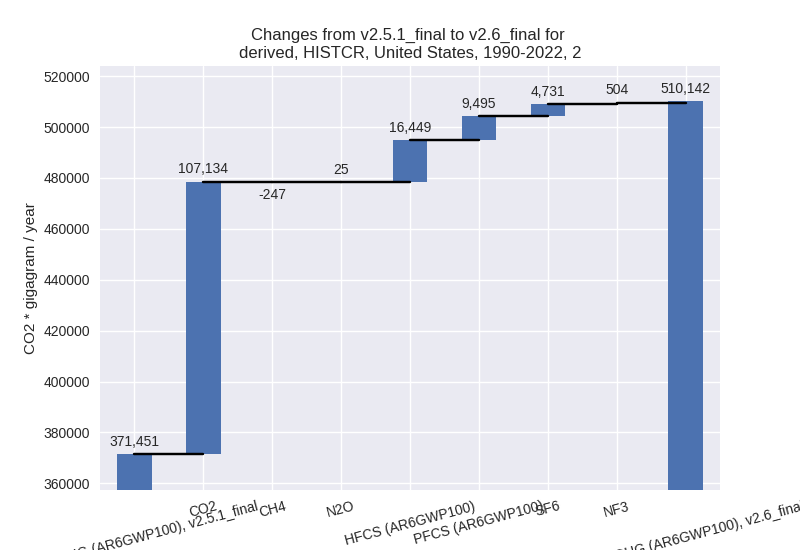
- M.AG: Total sectoral emissions in 2022 are 601640.40 Gg CO2 / year which is 9.4% of M.0.EL emissions. 2022 Emissions have changed by 0.8% (4635.39 Gg CO2 / year). 1990-2022 Emissions have changed by 0.9% (5401.48 Gg CO2 / year).
- 4: Total sectoral emissions in 2022 are 167194.80
Gg CO2 / year which is 2.6% of M.0.EL emissions. 2022 Emissions have
changed by -2.1% (-3565.90 Gg CO2 /
year). 1990-2022 Emissions have changed by -0.1% (-158.92 Gg CO2 / year). For 2022
the changes per gas
are:
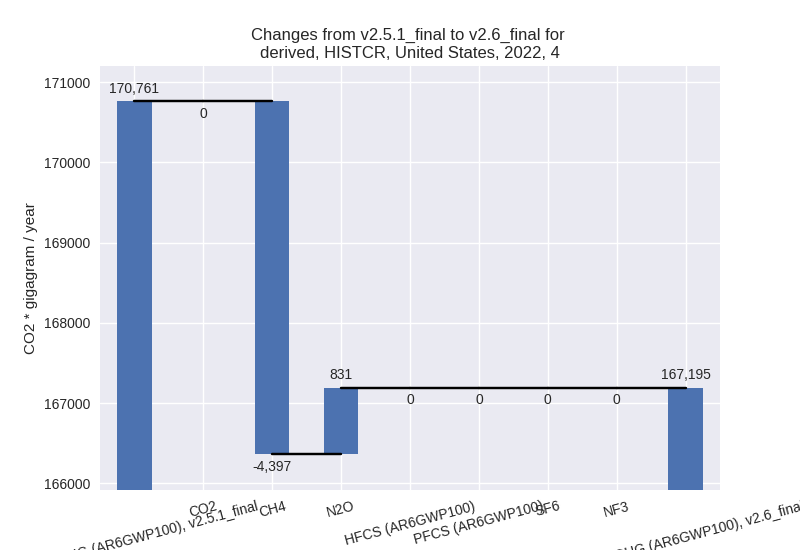
- 5: Total sectoral emissions in 2022 are 21238.55 Gg
CO2 / year which is 0.3% of M.0.EL emissions. 2022 Emissions have
changed by -10.6% (-2523.85 Gg CO2 /
year). 1990-2022 Emissions have changed by 12.5% (3259.31 Gg CO2 / year). For 2022
the changes per gas
are:
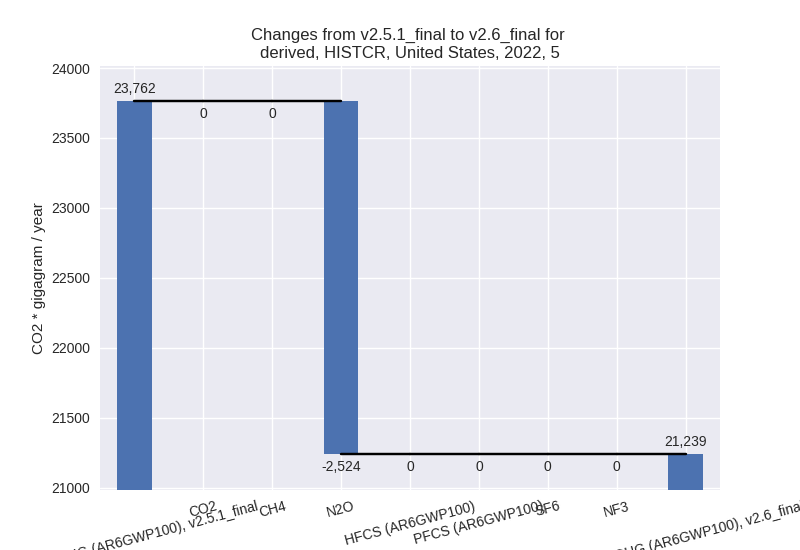
For 1990-2022 the changes per gas are: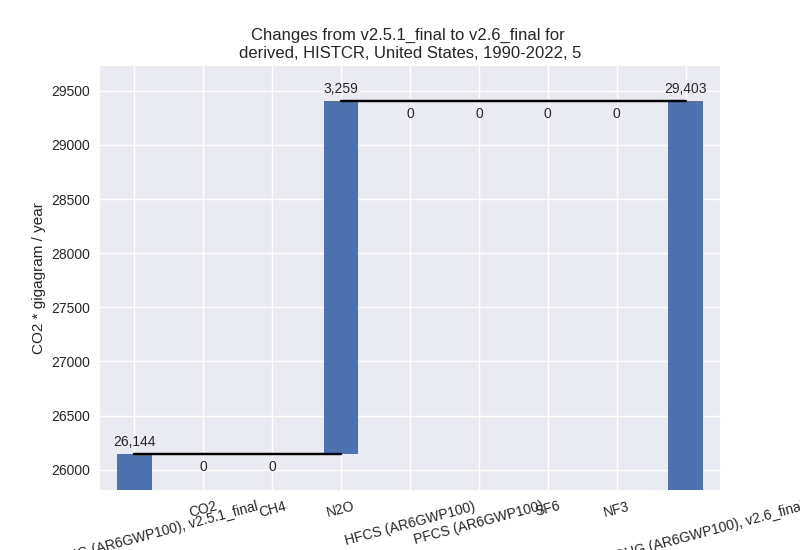
third party scenario (HISTTP):
Most important changes per time frame
For 2022 the following sector-gas combinations have the highest absolute impact on national total KyotoGHG (AR6GWP100) emissions in 2022 (top 5):
- 1: 1.A, CO2 with -31737.90 Gg CO2 / year (-0.7%)
- 2: 2, HFCS (AR6GWP100) with 5360.35 Gg CO2 / year (3.0%)
- 3: 4, CH4 with 4099.64 Gg CO2 / year (2.9%)
- 4: 2, SF6 with -3423.25 Gg CO2 / year (-10.2%)
- 5: 5, N2O with -2523.85 Gg CO2 / year (-13.6%)
For 1990-2022 the following sector-gas combinations have the highest absolute impact on national total KyotoGHG (AR6GWP100) emissions in 1990-2022 (top 5):
- 1: 5, N2O with 3259.31 Gg CO2 / year (15.5%)
- 2: 1.A, CO2 with -1487.00 Gg CO2 / year (-0.0%)
- 3: 4, CH4 with 605.52 Gg CO2 / year (0.4%)
- 4: 2, HFCS (AR6GWP100) with 162.43 Gg CO2 / year (0.2%)
- 5: 2, N2O with 141.19 Gg CO2 / year (0.6%)
Changes in the main sectors for aggregate KyotoGHG (AR6GWP100) are
- 1: Total sectoral emissions in 2022 are 5130962.60 Gg CO2 / year which is 84.6% of M.0.EL emissions. 2022 Emissions have changed by -0.6% (-31703.60 Gg CO2 / year). 1990-2022 Emissions have changed by -0.0% (-1494.55 Gg CO2 / year).
- 2: Total sectoral emissions in 2022 are 375862.38 Gg CO2 / year which is 6.2% of M.0.EL emissions. 2022 Emissions have changed by 1.1% (3920.02 Gg CO2 / year). 1990-2022 Emissions have changed by 0.6% (1708.25 Gg CO2 / year).
- M.AG: Total sectoral emissions in 2022 are 385989.02 Gg CO2 / year which is 6.4% of M.0.EL emissions. 2022 Emissions have changed by 0.0% (0.00 Gg CO2 / year). 1990-2022 Emissions have changed by 0.0% (0.00 Gg CO2 / year).
- 4: Total sectoral emissions in 2022 are 153020.10
Gg CO2 / year which is 2.5% of M.0.EL emissions. 2022 Emissions have
changed by 2.8% (4185.14 Gg CO2 /
year). 1990-2022 Emissions have changed by 0.4% (615.29 Gg CO2 / year). For 2022 the
changes per gas
are:
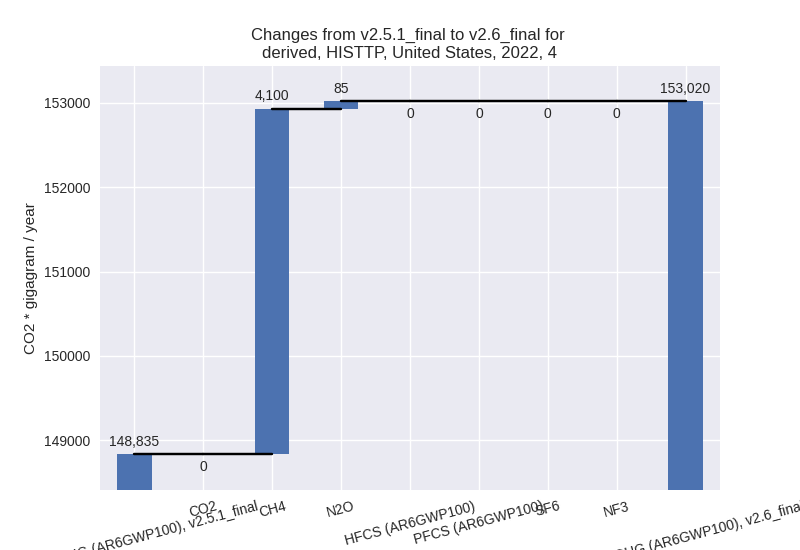
- 5: Total sectoral emissions in 2022 are 21238.55 Gg
CO2 / year which is 0.4% of M.0.EL emissions. 2022 Emissions have
changed by -10.6% (-2523.85 Gg CO2 /
year). 1990-2022 Emissions have changed by 12.5% (3259.31 Gg CO2 / year). For 2022
the changes per gas
are:

For 1990-2022 the changes per gas are: